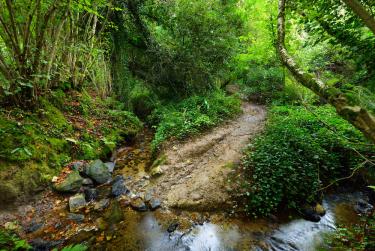Stream Crossings
Any time a road or trail crosses a stream, care must be taken. If stream crossings are not designed and maintained using Best Management Practices, they can change the speed, depth and flow of streams, damage water quality and deny essential passages to fish and other aquatic species.
Carefully planning your road system is the first step in protecting stream water quality. When looking at a map of your property consider whether you can design your roads to avoid stream crossings altogether. If not, one of the most important decisions you can make about a stream crossing is location. So, rather than planning your road system and then figuring out a stream crossing as an after thought, make the optimal crossing location your starting point and design the road system from there.
You will need to plan a crossing location based on the optimum characteristics of the stream channel, stream banks and the approach to the crossing. Specifically, look for a location where:
The stream is strait and narrow.
- The stream has low banks.
- The stream bed is firm and rocky.
- The road can approach the stream at a very low gradient.
Once you find the best location, you will want to consider the type of crossing that works best for the stream and your needs. In general, stream crossings should be designed to handle expected loads and uses with the least amount of disturbance to the stream flow and channel depth. Considerations include making sure the size of the crossing fits the stream, and whether it should be a temporary crossing or permanent. You can get help designing the right stream crossing from your state Department of Natural Resources and a professional forester. Some Best Management Practices they can help you integrate into the design of your crossing include:
- Identifying the best stream crossing location.
- Timing construction to protect water quality and fish passage during spawning season.
- Installing stream crossing structures at right angles to the stream where possible.
- Using soil stabilization techniques on exposed soil to minimize erosion.
- Designing the crossing to provide passage for fish and other aquatic species.
- Using non-toxic materials to protect water quality and wildlife.
- Minimizing alterations to the stream channel and the amount of excavation needed at crossings.
- Limiting activity in the streambed to periods of low flow or no flow.
- Employing techniques to prevent sediment and road runoff from entering the stream.
- Designing the crossing to handle peak flows.
Because stream crossings have potential negative impacts for streams, some states require permits for construction of crossings. These permits may be limited to streams that are considered “navigable” or having a defined bed and being passable by a canoe or other small watercraft on a recurring basis. It’s always best to check in with your local and state environmental resources office to be certain what regulations apply.
Temporary or Permanent Crossing?
Deciding whether to do a temporary or permanent crossing will depend on the frequency, intensity and season of your use of the road. Temporary crossings can include timber mats, pole fords and portable bridges. Common permanent crossings are culverts, bridges and fords. Deciding which type and the proper design is important for stream health and the lifespan and cost of your crossing. Consulting with a good professional forester can help immensely with this important decision.
How can I get more tips?
It’s simple! Enter your email below.

